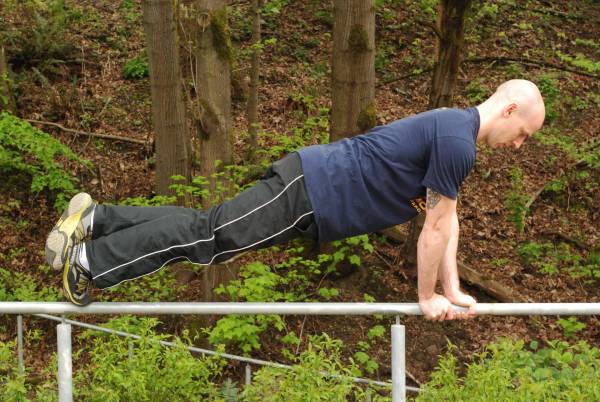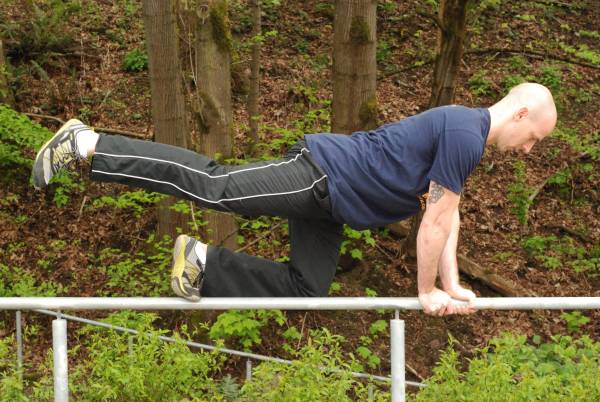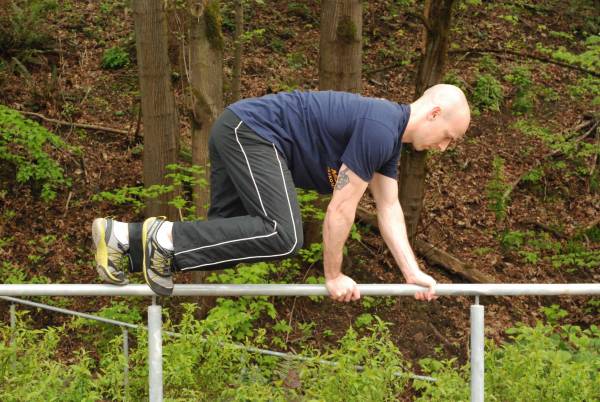Can you name the ninth physical skill, of the infamous Ten General Physical Skills promulgated by Jim Crawley and Bruce Evans? It’s a crucial one, and is always something that athletes can improve upon. I’ll give you a big hint: without it you fall over. Now you know what I’m talking about, right?
Balance.
Power, speed, and endurance often get the most recognition as the foundation of strong athletic ability. Think of everyone from soccer players to wrestlers. The ability to generate high levels of force and sustain it longer than your competitor can often determine who will be victorious in a given sport. Yet, without a high degree of balance executed at just the right time, say during a corner kick or a shoulder throw, all can be lost in an instant.
I’ll venture to say that of the ten physical skills, balance is the one that we don’t spend enough time developing. People often think that high levels of balance are just something you are either born with or you aren’t. There is some truth to that, but nonetheless is it is also something that responds remarkably well to persistent training.
I know this first hand, as someone who has been practicing parkour for many years, and also as a physical therapist who helps keep eighty year olds from falling down. Quite simply, your balance responds very well to targeted practice. Work on it and it gets better.
As your balance improves, so does your overall athletic skill. Having mastery of your body in space allows a higher degree of movement complexity, which can mean all of the difference during a critical soccer kick or a wrestling offense. Keeping your center of gravity over your base of support when you are in challenging positions and spatial arrangements determines whether you end up on the floor or get to pump your fists in victory.
So, I’ve got a set of fun balance challenges for you. These series of movements come from basic parkour conditioning and are utilized to improve balance on a narrow surface. You might not recognize the immediate benefit to your specific discipline, but consider them as a way to improve your overall spatial awareness, coordination, and most importantly, balance.
Prior to starting the challenges, find a level handrail that extends horizontally for at least ten feet. It can be a flat bar or round tubing – the tubing is preferable. You’ll be balancing on top of the bar, so make sure it is free of dust or condensation. You don’t want the challenge to be harder than it needs to be!
The first challenge is called a Rail Plank:
- Lift yourself on top of the rail, place your hands next to each other, and secure your grip.
- Extend your legs behind you and balance on the tiptoes of one foot.
- Your other foot should be resting on the ankle of your bottom leg.
- Straighten your arms and engage your trunk muscles, as you press up into a plank position.
- Stay tight through your shoulders and hips, while trying to hold the position for as long as you can.
- Use your wrist muscles to control your side-to-side motion.
- Shoot for a goal of 30 seconds.

When the rail plank becomes too easy, make it harder by turning it into a push-up. Try lowering your chest to the bar and then pressing back up to a plank, for multiple reps.
The second challenge is a 3-Point Rail Balance:
- Get on top of a bar in a semi-kneeling position, with your hands side-by-side and your hips elevated.
- You should be balanced between your toes and you hands, with your knees flexed and your spine horizontal.
- Now, lift one foot from the rail and try to stay balanced for as long as you can.
- Try lifting opposite leg on your next attempt.
- Also play with raising one hand off the rail.
- See if you can master lifting each limb from the rail, one at a time.

Once you are proficient with the 3-point balance for at least 10 seconds, make it harder by lifting your opposite arm and leg from the rail. The 2-point rail balance takes serious concentration.
The final challenge is to balance and walk like a cat, AKA Cat Balance:
- Begin in the same starting position as the 3-point rail balance.
- Your opposite arm and leg should be in synch with each other, staggered forward or backward of the other side.
- Practice holding this position for at least 30 seconds and find your ideal hip elevation.
- Now, lift one hand and reach forward, to begin crawling along the rail.
- Move your opposite foot, to stay in synch with the arm.
- As you get more comfortable on the rail, try advancing the opposite arm and leg together, so you are momentarily balanced on just two points of contact.
- Shoot for distance on this exercise – try to go for as far as you can!

Make the cat balance harder by trying it on a rail that has a gentle upward slope.
There you have it: three pieces of beginner rail work to try as your homework. Be patient, have fun, and watch as the improved balance starts to impact your general athletic ability.
In a future article, I’ll introduce more advanced rail work, including standing balance activities. Stay tuned!
Wrestling photo courtesy of Shutterstock.






